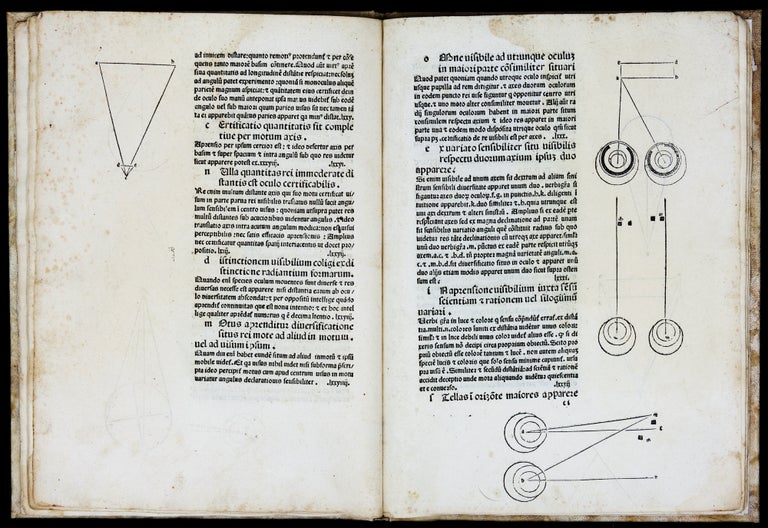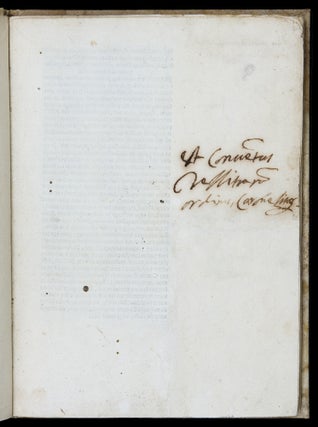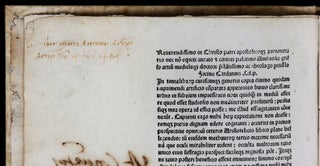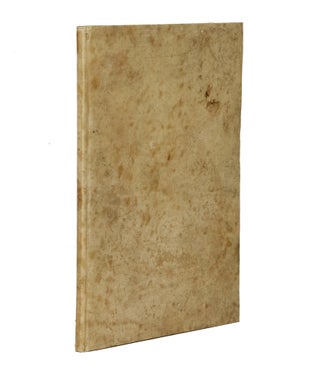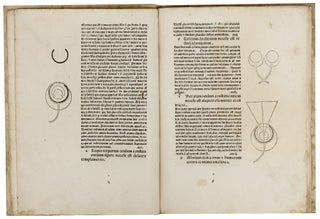Perspectiva co(mmun)is.
First. Small folio [27 x 19.5 cm], (30) ff, with (77) woodcut diagrams in margins. Bound in later vellum over boards, later endpapers. Housed in a black morocco bookbox, date & title stamped in gold on spine; interior in green suede. Scattered mostly marginal waterstaining; occasional minor handsoiling & staining to several leaves; lower left part of blank margin of a1 restored. PROVENANCE: Bookplate on inside front cover of TV; inscription on a1r naming the Bibliotheque monastique des Carmelites and on a1v Liber Marci Antoni 1484. Rare first edition of the first publication on optics (perspectiva), and a crucial text that was studied by Leonardo da Vinci. Johannes de Peckham’s (England c. 1230-1292) Perspectiva communis is illustrated with 77 woodcut diagrams depicting the human eye, the nature of vision, and the eye’s role in the representation of space. Published in Milan by Petrus de Corneno in the first years of the 1480s, this first edition is of particular importance in the history of art for its close connection to Leonardo da Vinci (1452-1519) during the artist’s period of activity in Milan. “Leonardo owned Pecham’s book, which is listed in the book list in the Madrid Codex II” (Azzolini, p. 171): “I here record the books I keep locked up in a chest” (fol. 2v). Indeed, his friend, Fazio Cardano, “edited John Peckham’s Perspectiva communis ... which Leonardo had the opportunity on many occasions to study and discuss with him. Leonardo, who arrived in Milan in 1482, just as the present volume was being published, frequently refers to Cardano in his notebooks. It was through these readings and conversations with Cardan that Leonardo expanded his thinking about perspective, mathematics, and the function of the eye. The eye was of particular importance to him, not only as an object of study in itself, but because it was the means by which all visible phenomena are brought into the mind” (Sherwin Nuland, Leonardo da Vinci: A Life). Leonardo even translated into Italian Peckham’s famous paean to vision from the opening of Perspectiva communis (in the Codex Atlanticus, f. 542r). The artist’s writings on the ‘visual pyramid’ as a symbolic form useful for constructing the illusion of three dimensions on a two-dimensional surface seems also to have owed much to Peckham’s diagrams (see Kemp, p. 47). Leonardo’s sojourn in Milan lasted from 1482 to 1499 and during this period he is famously known to have collaborated with Luca Pacioli on the De divina proportione (written in 1496-98 but not published until 1509), one of the richest sources for studying the interplay of mathematics, vision, art, and perspective in the High Renaissance. In his notebooks in 1495-99, Leonardo several times reminded himself to ask Cardano for this or that book “on proportions,” suggesting that their discussions easily ranged from theories of optics and vision to more concrete matters of artistic practice and representation [see Azzolini, pp. 171-2]. Pacioli’s De divina proportione contains 60 figures drawn by Leonardo representing geometrical solids and includes his famous proportion of the body inspired by Vitruvius. A casual comparison between the layouts of Peckham’s text and the two texts Pacioli was producing in the 1490’s (i.e., the Summa Arithmetica and De Divina Proportione) with their substantial use of marginal diagrams, suggests a stylistic connection between them difficult to ignore, especially given Leonardo’s considerable relationship with these works. Peckham’s work is considered the “the most widely used of all optical texts from the early fourteenth until the close of the sixteenth century [and] it remains today the best index of what was known to the scientific community in general on the subject” (Lindberg, DSB). The volume is believed to predate Erhardt Ratdolt’s celebrated edition of Euclid’s Elements (Venice, 1482) which would give it the distinction of being “the first printed book illustrated with diagrams” (Mortimer, no. 367; also, Thomas-Stanford, p. 3 and Gejertsen, p. 70). The Perspectiva communis was crucial in introducing ancient Greek, Arab and medieval theories of vision to early modern artists and scientists, including such luminaries as Leon Battista Alberti (see Kemp, p. 26), Lorenzo Ghiberti (1378-1455) who discusses Peckham in his Commentarii), Jean Pélerin (see Kemp, p. 65), and Giambattista della Porta (1535-1615). That the only mathematical work owned by the great humanist Coluccio Salutati was a copy of Peckham’s Perspectiva underlines the text’s wide and long-lasting appeal as a bridge between the arts and sciences (see Rose, p. 27). The Perspectiva communis is divided into three parts. “In the first book Pecham discussed the propagation of light and color, the anatomy and physiology of the eye, the act of visual perception, physical requirements for vision, and the errors of direct vision. In book II he discussed vision by reflected rays and presented a careful and sophisticated analysis of image formation by reflection. Book III was devoted to the phenomenon of refraction, the rainbow, and the Milky Way. The central theme of the Perspectiva … is the theory of direct vision … Pecham argued that the emission of visual rays from the observer’s eye is neither necessary nor sufficient as an explanation of sight; the primary agent of sight is therefore the ray coming to the eye from a point on the visible object” (DSB, p. 475). Peckham’s (partial) advocacy of the intromission theory of vision thus represents an early Western example of the dissatisfaction with the ancient world’s extramission theory, a problem that would be taken up by Leonardo and would remain unresolved even in the writings of Newton and Locke. “Pecham relied on a wide variety of sources for his ideas on optics, [but] of these, Alhazen is by far the most significant, and Pecham could speak of his intention to ‘follow in the footsteps’ of the auctor. Indeed, […] it is appropriate to conceive of Pecham’s Perspectiva communis as a compendium of Alhazen’s optics, designed to communicate Alhazen’s essential achievement to an audience that required an introductory account” (Lindberg, Theories of Vision, 116). Having studied the works of Alhazen, al-Kindi and Avicenna, Peckham made his most original contribution with his description of concave refracting surfaces, the first description of such glasses in a printed work. The work’s greater importance lies in its planting the seed for later attempts to make the study of perspective more mathematically rigorous: Peckam’s Perspectiva communis, Witelo’s Perspectiva, and Latin translations of Alhazen were at the forefront of the incorporation of optical studies in the university curriculum from the early 14th century, with these works being found in the libraries and on the syllabi of the Sorbonne, Oxford, Cambridge, and the universities of Vienna, Prague, Leipzig, Alcalá, and Salamanca (Lindberg, Theories of Vision, 120-21). The treatise was cited by, among others, Dominicus de Clavasio, Henry of Langenstein, Blasius of Parma, Albert Brudzewski, Francesco Maurolico, Girolamo Fabrici, Johannes Kepler, Willebrord Snellius, and G. B. Riccioli. The present edition is undated and is one of only six titles assigned to the press of Petrus de Corneno, with the others dating to 1480-1. The work opens with Cardano’s dedication to the Milan physician Ambrosius Griffus (1420-93) and closes with a charming Latin poem in seven distichs in which the names of Corneno and Cardano are mentioned as puns. The next edition of the Perspectiva communis appeared in Valencia in 1503, and then in 1504 from the press of Sessa in Venice. Significantly, Lindberg considers these earliest editions more faithful to Peckham than those with later editorial interventions (such as Hartman’s), into which Renaissance advances in physiology were retrojected (Pecham and the Science of Optics, pp. 57-8). * Goff J394; Hain 9425*; Klebs 738.1; Sander 5504; Pell Ms 9124 (8966); CIBN J-255; Parguez 608; IGI 7385; IDL 2699; CCIR J-60; IBE 3254; Lőkkös(Cat BPU) 344; Martín Abad J-63; Voull(B) 3099; Sack(Freiburg) 2108; Bod-inc J-177; Sheppard 4975; Pr 5974; BMC VI 759; BSB-Ink I-499; GW M30474; Mortimer, Italian, no. 367; Essling 2, 1, 1427; Sander 5503; Vagnetti Db8; D. C. Lindberg in DSB X.473-76; Lindberg, John Pecham and the Science of Optics, pp. 56-7; Lindberg, Theories of Vision from Al-Kindi to Kepler, passim; “The Perspectiva communis of John Pecham: Its influence, Sources and Content,” Archives internationale d’histoire des sciences 18 (1965) 37-53; Thorndike pp. 165-169; Rose, The Italian Renaissance of Mathematics, p. 120 & 135; M. Azzolini, “Leonardo da Vinci’s Anatomical Studies in Milan: A Re-examination of Sites and Sources,” in Visualizing Medieval Medicine and Natural History, 1200-1500, J. A. Givens et al. eds., pp. 147-176; C. Thomas-Stanford, Early Editions of Euclid’s Elements; D. Gejertsen, The Classics of Science; M. Kemp, The Science of Art: Optical Theories of Western Art from Brunelleschi to Seurat; P. L. Rose, The Italian Renaissance of Mathematics: Studies on Humanists and Mathematicians from Petrarch to Galileo. Sherwin Nuland, Leonardo da Vinci: A Life.
Price: $135,000.00

